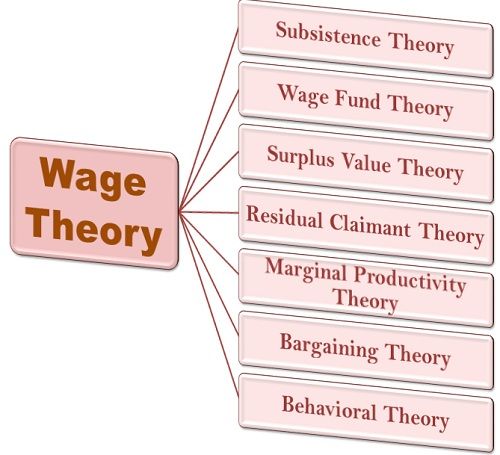The workers are paid wages or salaries for the work done by them. Thus, the return to the workers should be according to their efforts and the pay standards prevailing in the industry.
There are several theories of wage determination propounded by different scientists and are based on varied assumptions.
Theories of Wage Determination
- Subsistence Wage Theory: This theory was propounded by David Ricardo and called this theory as an “iron law wages.” According to this theory, the labor is paid the minimum amount of wage that is sufficient to subsist and perpetuate their race without either increase or decrease. It is based on the assumption that the law of diminishing returns applies to the industry, and the population tends to increase.
If the labor is paid below the subsistence level, they will die out of malnutrition, disease or hunger and therefore, the number of workers gets reduced. On the other hand, if the wage increases above the subsistence level, the number of workers will get attracted to procreate and thus, with the increase in labors the wage rate comes down. Thus, there is a subsistence level, which is maintained and is not either increased or decreased.
- Wage Fund Theory: This theory was developed by Adam Smith, and is based on the assumption that the wage is paid out of the pre-determined wealth or fund, which lays surplus with the wealthy persons, as a result of savings. The amount of wage to be paid to the worker depends on the size of the fund. Larger the fund, more labor would be employed and given higher wages, whereas in the case of less funds, the wage would reduce to the subsistence level.
This theory was further expounded by J.S.Mill, and according to him the wage fund is fixed, and the wages can be determined on the basis of demand for and supply of labor. And thus, the fund size decides the demand for the labor. To have an increased wage, the number of labor is to be reduced, and the fund is to be enlarged.
- Surplus Value Theory: This theory is given by Karl Marx, and according to him, like other articles, labor is also an article of commerce and could be purchased by paying a subsistence price.
The price of a product is determined by the amount of time; a labor devotes for its production. And the proportion of time spent by the labor on work is much less and, therefore, paid a minimum price and the surplus amount is utilized for the other expenses.
- Residual Claimant Theory: Francis. A Walker propounded this theory, and according to him there four factors of production viz. Land, labor, capital and entrepreneurship.
The wage is the amount given in return for the amount of production and thus is paid after the payment of all other factors. Thus, the wage is considered to be a residual claimant, and is computed as:
Wage= Whole production- (Rent+ Interest+ Profit)
- Marginal Productivity Theory: This theory is given by Phillips Henry Wicksteed and John Bates Clark, and it is based on the assumption that wage is determined on the basis of last worker’s contribution in the production i.e. the marginal production.
This theory assumes that wage depends on demand for and supply of labor. As far as, the marginal productivity is equal to the wages paid, a firm will continue employing more labor.
- Bargaining Theory: John Davidson has given this theory, and according to him, the wages are determined on the basis of a bargaining capacity of workers or their unions and employers. If the trade union is stronger, then the wages will be high, and if the employer is powerful, the wages tend to be low.
- Behavioral Theory: Several behavioral scientists (viz. March and Simon, Robert Dubin, Eliot Jacques,) have presented their research on the wage determination. According to them, there are various factors such as employer’s concern for the workers, the strength of unions, size and prestige of company, etc. that determines the amount of wage to be disbursed among the workers.
Thus, the firm can adopt either of the wage methods depending on the nature of a job and the worker’s contribution towards the accomplishment of a work.


DRIBAREO CLAUDIA says
very interesting and clear explanation
Nalwoga Annet says
Thank you for this opportunity